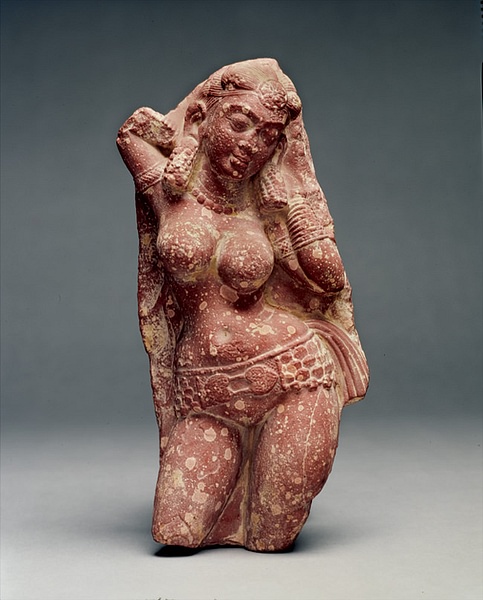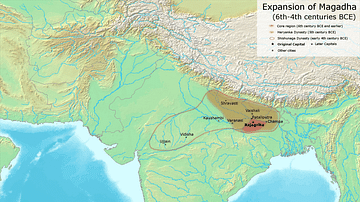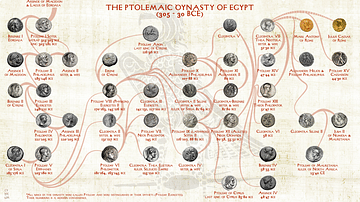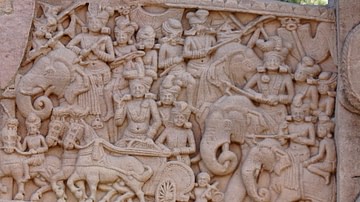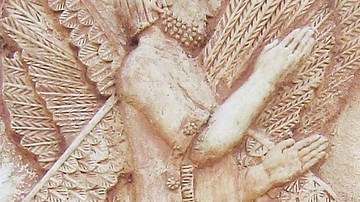Cyrus the Great (558-530 BCE) built the first universal empire, stretching from Greece to the Indus River. This was the famous Achaemenid Empire of Persia. An inscription at Naqsh-i-Rustam, the tomb of his able successor Darius I (521-486 BCE), near Persepolis, records Gadara (Gandhara) along with Hindush (Hindus, Sindh) in the long list of satrapies of the Persian Empire.
By about 380 BCE the Persian hold on Indian regions slackened and many small local kingdoms arose. In 327 BCE Alexander the Great overran the Persian Empire and located small political entities within these territories. The next year, Alexander fought a difficult battle against the Indian monarch Porus near the modern Jhelum River. East of Porus' kingdom, near the Ganges River, was the powerful kingdom of Magadha, under the Nanda Dynasty.
Plutarch (46-120 CE) was a Greek historian, biographer and essayist, known primarily for his Parallel Lives and Moralia. He gives an interesting description of the situation:
As for the Macedonians, however, their struggle with Porus blunted their courage and stayed their further advance into India. For having had all they could do to repulse an enemy who mustered only twenty thousand infantry and two thousand horse, they violently opposed Alexander when he insisted on crossing the river Ganges also, the width of which, as they learned, was thirty-two furlongs, its depth a hundred fathoms, while its banks on the further side were covered with multitudes of men-at arms and horsemen and elephants.
Exhausted and frightened by the prospect of facing another giant Indian army at the Ganges River, his army mutinied at the Hyphasis (modern Beas River), refusing to march further East. Alexander left behind Greek forces which established themselves in the city of Taxila, now in Pakistan.
After the death of Alexander the Great in 323 BCE, Seleucus I Nicator was nominated as the satrap of Babylon in 320 BCE. Antigonus I forced Seleucus to flee from Babylon, but, supported by Ptolemy I, he was able to return in 312 BCE. Seleucus' later conquests include Persia and Media. He invaded what is now Punjab in northern India and Pakistan in 305 BCE.
Early Allusion to the Greeks in India
Long before the arrival of Alexander the Great on India's north-western border, there are references in early Indian literature calling the Greeks Yavanas. Pāṇini, an ancient Sanskrit grammarian, was acquainted with the word yavana in his composition. Katyayana explains the term yavanānī as the script of the Yavanas. Nothing much is known about Pāṇini's life, not even the century he lived in. The scholarly mainstream favours the 4th century BCE. Pāṇini's grammar, known as Ashtadhyayi, meaning eight chapters, defines classical Sanskrit so that Pāṇini by definition lived at the end of the Vedic period: An important hint for the dating of Pāṇini is the occurrence of the word yavanānī (in 4.1.49, either "Greek woman", or "Greek script"). It is unlikely there would have been first-hand knowledge of Greeks in Gandhara before the conquests of Alexander the Great in the 330s BCE, but it is likely that the name was known via the Old Persian word yauna, so that the occurrence of yavanānī taken in isolation allows for as early as 520 BC, i.e. the time of Darius the Great's conquests in India.
Katyayana (3rd century BCE) was Sanskrit grammarian, mathematician and Vedic priest who lived in ancient India. He explains the term yavanānī as the script of the Yavanas. He takes the same line as above that the Old Persian term yauna became Sanskritised to name all Greeks. In fact, this word appears in the Mahabharata.
Hellenization: The Cultural Legacy
The start of the so-called Hellenistic Period is usually taken as 323 BCE, the year of death of Alexander in Babylon. During the previous decade of invasion, he had conquered the whole Persian Empire, overthrowing King Darius. The conquered lands included Asia Minor, the Levant, Egypt, Mesopotamia, Media, Persia and parts of modern Afghanistan, Pakistan and parts of the steppes of central Asia, almost the entire earth known to the Greeks at that time.
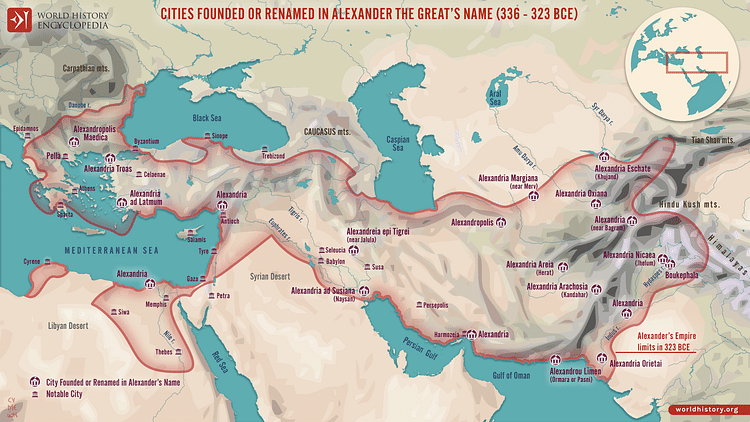
As Alexander marched deeper into the East, distance alone presented him with a serious problem: how was he to remain in touch with the Greek world left behind? A physical link was vital as his army drew supplies and reinforcement from Greece and, of course, Macedonia. He had to be sure he was never cut off. He thought of a unique plan.
He went on planting military colonies and cities in strategic places. At those places, Alexander left Greek mercenaries and Macedonian veterans who were no longer involved in active campaign. Besides keeping the supply routes open, those settlements served the purpose of dominating the countryside around them.
Their military significance apart, Alexander's cities and colonies became powerful instruments in the spread of Hellenism throughout the East. Plutarch described Alexander's achievements:
Having founded over 70 cities among barbarian peoples and having planted Greek magistracies in Asia, Alexander overcame its wild and savage way of life.
Alexander had indeed opened the East to an enormous wave of immigration, and his successors continued his policy by inviting Greek colonists to settle in their realms. For 75 years after Alexander's death, Greek immigrants poured into the East. At least 250 new Hellenistic colonies were set up. The Mediterranean world had seen no comparable movement of peoples since the days of Archilochus (680-645 BCE) when wave after wave of Greeks had turned the Mediterranean basin into a Greek-speaking region.
One concrete and almost exotic example of these trends comes from the newly discovered Hellenistic city of Ay Khanoum. Situated on the borders of Russia and Afghanistan and not far from China, the city was mostly Greek. It had the typical Greek trappings of a gymnasium, a choice of temples, and administration buildings. It was not, however, purely Greek. It also contained an oriental temple and artistic remains that showed that the Greeks and the natives had already embraced aspects of each other's religions. One of the most curious discoveries was a long inscription written in Greek verse by Clearchus, a pupil of Aristotle. The inscription, carved in stone, was put up in a public place for all to see. Clearchus had simply copied the precepts of famous Greeks. The inscription was philosophy for the common people, a contribution to popular culture. It provided the Greeks with a link to their faraway homeland. It was also an easy way to make at least some of Greek culture available to residents.
Alexander's settlement of Greek colonists and culture in the east resulted in a new Hellenistic culture, aspects of which were evident until the mid-15th century CE. The overall result of Alexander's settlements and those of his successors was the spread of Hellenism as far east as India. Throughout the Hellenistic period, Greeks and Easterners became familiar with and adapted themselves to each other's customs, religions, and ways of life. Although Greek culture did not entirely conquer the East, it gave the East a vehicle of expression that linked it to the West. Hellenism became a common bond among the East, peninsular Greece, and the western Mediterranean. This pre-existing cultural bond was later to prove quite valuable to Rome, itself strongly influenced by Hellenism in its efforts to impose a comparable political unity on the known world.
Hellenization is a term coined by the German historian Johann Gustav Droysen to denote the spread of Greek language, culture, and population into the former Persian Empire after Alexander's conquest. That this export took place is certain, and can be seen in the great Hellenistic cities such as Alexandria in Egypt (one of around twenty towns founded by Alexander), Antioch in modern Syria and Seleucia south of modern Baghdad. However, just how widespread and deeply permeating this was, and to what extent it was a conscious policy, is debatable. Alexander's successors openly rejected such policies after his death.
Trade in the Hellenic World
In many respects, the Hellenistic city resembled a modern city. It was a cultural centre with theatres, temples, and libraries. It was a seat of learning, home of poets, writers, teachers, and artists. It was a place where people could find amusement. The Hellenistic city was also an economic centre that provided a ready market for grain and produce raised in the surrounding countryside. The city was an emporium, scene of trade and manufacturing. In short, the Hellenistic city offered cultural and economic opportunities but did not foster a sense of united, integrated enterprise.
The Seleucid and Ptolemaic dynasties traded as far afield as India, Arabia, and sub-Saharan Africa. Overland trade with India and Arabia was conducted by caravan and was largely in the hands of Easterners. The caravan trade never dealt in bulk items or essential commodities; only luxury goods could be transported in this very expensive fashion. Once the goods reached the Hellenistic monarchies, Greek merchants took a hand in the trade.
Essential to the caravan trade from the Mediterranean to Afghanistan and India were the northern route to Dura on the Euphrates River and the southern route through Arabia. The desert of Arabia may seem at first unlikely and inhospitable terrain for a line of commerce, but to the east of it lay the plateau of Iran, from which trade routes stretched to the south and still farther cast to China. Commerce from the East arrived in Egypt and at the excellent harbours of Palestine, Phoenicia, and Syria. From these ports goods flowed to Greece, Italy, and Spain. The backbone of this caravan trade was the camel - shaggy, ill-tempered, but durable.
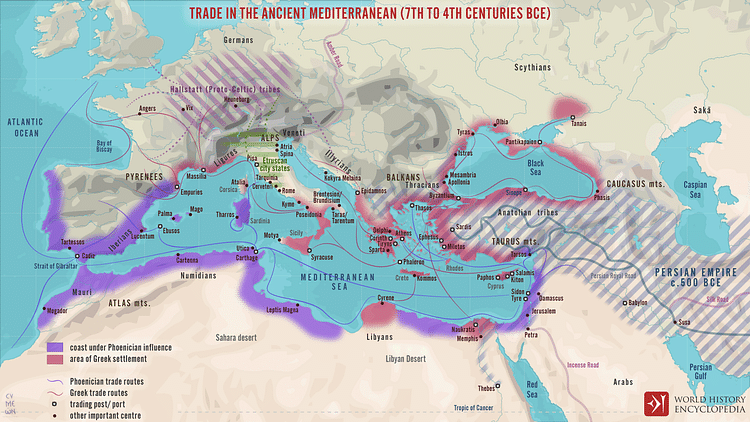
Over the caravan routes travelled luxury goods that were light, rare, and expensive. In time these luxury items became more of a necessity than a luxury. In part this development was the result of an increased volume of trade. In the prosperity of the period more people could afford to buy gold, silver, ivory, precious stones, spices, and a host of other easily transportable goods. Perhaps the most prominent goods in terms of volume were tea and silk. Indeed, the trade in silk gave the major route the name "Silk Road", for not only was this route prominent in antiquity but it was used until early modern times. In return, the Greeks and Macedonians sent east manufactured goods, especially metal weapons, cloth, wine, and olive oil.
Although these caravan routes can trace their origins to earlier times, they became far more prominent in the Hellenistic period. Business customs developed and became standardized so that merchants from different nationalities communicated in a way understandable to all of them.
Innovative Years on the Borders of India
There was a succession of more than thirty Hellenistic kings, often in conflict with each other, from 180 BCE to around 10 CE. This era is known as the Indo-Greek kingdom in the pages of history. The kingdom was founded when the Greco-Bactrian King Demetrius invaded India in 180 BCE, ultimately creating an entity which seceded from the powerful Greco-Bactrian kingdom centred in Bactria (today's northern Afghanistan). Since the term "Indo-Greek Kingdom" loosely described a number of various dynastic polities, it had several capitals, but the city of Taxila in modern Pakistan was probably among the earliest seats of local Hellenic rulers, though cities like Pushkalavati and Sagala (apparently the largest of such residences) would house a number of dynasties in their times.
During the two centuries of their rule, the Indo-Greek kings combined the Greek and Indian languages and symbols, as seen on their coins, and blended ancient Greek, Hindu and Buddhist religious practices, as seen in the archaeological remains of their cities and in the indications of their support of Buddhism. The Indo-Greek kings seem to have achieved a level of cultural syncretism with no equivalent in history, the consequences of which are still felt today, particularly through the diffusion and influence of Greco-Buddhist art.
According to Indian sources, Greek ("Yavana") troops seem to have assisted Chandragupta Maurya in toppling the Nanda Dynasty and founding the Mauryan Empire. By around 312 BCE Chandragupta had established his rule in large parts of the north-western Indian territories as well.
In 303 BCE, Seleucus I led an army to the Indus, where he encountered Chandragupta. Chandragupta and Seleucus finally concluded an alliance. Seleucus gave him his daughter in marriage, ceded the territories of Arachosia (modern Kandahar), Herat, Kabul and Makran. He in turn received from Chandragupta 500 war elephant which he used decisively at the Battle of Ipsus.
The peace treaty, and "an intermarriage agreement" (Epigamia, Greek: Επιγαμια), meaning either a dynastic marriage or an agreement for intermarriage between Indians and Greeks was a remarkable first feat in this campaign.
Megasthenes, the First Greek Ambassador
Megasthenes (350-290 BCE) was a Greek ethnographer in the Hellenistic period, author of the work Indica. He was born in Asia Minor (modern-day Turkey) and became an ambassador of Seleucus I to the court of Sandrocottus, who possibly was Chandragupta Maurya in Pataliputra (modern Patna in Bihar state), India. However, the exact date of his embassy is uncertain. Scholars place it before 288 BCE, the date of Chandragupta's death.
At the start of the Indica, Megasthenes talks about the older Indians who knew about the prehistoric arrival of Dionysus and Hercules in India. This story was quite popular amongst the Greeks during the Alexandrian period. He describes geographical features of India, such as the Himalayas and the island of Sri Lanka.
Especially important are his comments on the religions of the Indians. He mentions the devotees of Hercules (Shiva) and Dionysus (Krishna or Indra), but he does not write a word on Buddhists, something that gives ground to the theory that Buddhism was not widely spread in India before the reign of Ashoka (269-232 BCE).
Indica served as an important source to many later writers such as Strabo and Arrian. The 1st-century BCE Greek historian Apollodorus, quoted by Strabo, affirms that the Bactrian Greeks, led by Demetrius I and Menander, conquered India and occupied a larger territory than the Macedonians under Alexander the Great, going beyond the Hyphasis (modern Beas River) towards the Himalayas.
The Roman historian Justin also cited the Indo-Greek conquests, describing Demetrius as "King of the Indians" ("Regis Indorum"), and explaining that Eucratides in turn "put India under his rule" ("Indiam in potestatem redegit"). "India" only meant the upper Indus for Alexander the Great. Since the appearance of Megasthenes, "India" meant to the Greeks most of the northern half of the Indian subcontinent. Greek and Indian sources tend to indicate that the Greeks campaigned as far as Pataliputra until they were forced to retreat following a coup in Bactria in 170 BCE.
Appearance of Coins as the First Landmark
It is really difficult to know today where the idea of coinage first evolved. Based on available evidences, it appears that the notion of money (as coins, which by definition here would be a piece of metal of defined weight stamped with symbol of authority for financial transaction), was conceived by three different civilizations independently and almost simultaneously. Coins were introduced as a means to trade things of daily usage in Asia Minor, India and China in the 6th century BCE. Most historians agree that the first coins of world were issued by Greeks living in Lydia and Ionia (located on the western coast of modern Turkey). These first coins were globules of Electrum, a naturally occurring alloy of gold and silver. These were crude coins of definite weight stamped with punches issued by the local authorities in about 650 BCE.
Both, literary and archaeological evidence confirm that the Indians invented coinage somewhere between the 5th and 6th centuries BCE. A hoard of coins discovered at Chaman Huzuri in 1933 CE contained 43 silver punch-marked coins (the earliest coins of India) mixed with Athenian (coins minted by Athens city of Greece) and Achaemenid (Persian) coins. The Bhir (Taxila in modern Pakistan) hoard discovered in 1924 CE contained 1055 punch-marked coins in very worn-out condition and two coins of Alexander in mint condition. This archaeological evidence clearly indicates that the coins were minted in India long before the 4th century BCE — i.e. before Greeks advanced towards India. Pānini wrote his Ashtadhyayi in the 4th or 5th century BCE in which he mentioned Satamana, Nishkas, Sana, Vimastika, Karshapana and its various sub-divisions to be used in financial transactions. Thus, coins were known in ancient Indian literature from 500 BCE. There is also a strong belief that silver as a metal which was not available in Vedic India (pre-600 BCE). It became abundantly available by 500-600 BCE. Most of the silver came from Afghanistan and Persia as a result of international trade.
The first Greek coins to be minted in India, those of Menander I and Appolodotus I bear the mention "Saviour king" (BASILEOS SOTHROS), a title with high value in the Greek world. For instance, Ptolemy I had been Soter (saviour) because he had helped save Rhodes from Demetrius the Besieger, and Antiochus I because he had saved Asia Minor from the Gauls. The title was also inscribed in Pali (the Kharoṣṭhī script) as Tratarasa on the reverse of their coins. Menander and Apollodotus may indeed have been saviours to the Greek populations residing in India.
Most of the coins of the Greek kings in India were bilingual, written in Greek on the front and in Pali on the back, a superb concession to another culture never before made in the Hellenic world. From the reign of Apollodotus II, around 80 BCE, Kharoshthi letters started to be used as mintmarks on coins in combination with Greek monograms and mintmarks. It suggested the participation of local technicians to the minting process. Incidentally, these bilingual coins of the Indo-Greeks were the key in the decipherment of the Kharoṣṭhī script by James Prinsep (1799 –1840 CE).
The Kharoṣṭhī script, is an ancient abugida (or "alphasyllabary") used by the Gandhara culture, nestled in the historic northwest South Asia to write the Gāndhārī and Sanskrit languages. It was in use from the middle of the 3rd century BCE until it died out in its homeland around the 3rd century CE. It was also in use in Kushan, Sogdiana and along the Silk Road where there is some evidence it may have survived until the 7th century CE in the remote way stations of Khotan and Niya.
The coinage of the Indo-Greeks remained in fact influential for several centuries throughout the Indian subcontinent:
- The Indo-Greek weight and size standard for silver drachms was adopted by the contemporary Buddhist kingdom of the Kunindas in Punjab, the first attempt by an Indian kingdom to produce coins that could compare with those of the Indo-Greeks.
- In central India, the Satavahanas (2nd century BCE- 2nd century CE) adopted the practice of representing their kings in profile, within circular legends.
- The direct successors of the Indo-Greeks in the northwest, the Indo-Scythians and Indo-Parthians continued displaying their kings within a legend in Greek, and on the obverse, Greek deities.
- To the south, the Western Kshatrapas (1st-4th century CE) represented their kings in profile with circular legends in corrupted Greek.
- The Kushans (1st-4th century CE) used the Greek language on their coinage until the first few years of the reign of Kanishka, whence they adopted the Bactrian language, written with the Greek script.
- The Guptas (4th-6th century CE), in turn imitating the Western Kshatrapas, also showed their rulers in profile, within a legend in corrupted Greek, in the coinage of their western territories.
The latest use of the Greek script on coins corresponds to the rule of the Turkish Shahi of Kabul, around 850 CE.
Rise of Menander
Menander (Milinda), originally a general of Demetrius, is probably the most successful Indo-Greek king, and the conqueror of the vastest territory. The finds of his coins are the most numerous and the most widespread of all the Indo-Greek kings. From at least the 1st century CE, the "Menander Mons", or "Mountains of Menander", came to designate the mountain chain at the extreme east of the Indian subcontinent, today's Naga Hills and Arakan, as indicated in the Ptolemy world map of the 1st century. Menander is also remembered in Buddhist literature (the Milinda Panha) as a convert to Buddhism: he became an arhat (Buddhist ascetic) whose relics were enshrined in a manner reminiscent of the Buddha. He also introduced a new coin type, with Athena Alkidemos ("Protector of the people") on the reverse, which was adopted by most of his successors in the East.
Coming of Buddhism in India
It is necessary to deal with the coming of Buddhism in India as a turning point in the world of art and culture, philosophy and religion. More than all other religious faiths, the Greco-Indian approach to the new dawn across Asia and Europe was mainly due to the Buddhism during the centuries under discussion here.
Buddha passed away at the age of eighty, sometime between the years 486 and 473 BCE, probably nearer the former date than the latter. A few modern authorities believe that Buddha never intended to set up a new religion and he never looked on his doctrine as distinct from the popular cults of the time. However questionable this view may be, his simpler followers raised his status almost to divinity during his lifetime, and after his death, worshipped him through his symbols—the stupa, recalling his parinirvana and the Bodhi tree, recalling his enlightenment. According to tradition, disciples and the neighbouring rulers divided his ashes, and the recipients built stupas over them. In the third century BCE, Ashoka uncovered the ashes from their original resting places and dispersed those, creating stupas all over India.
The carvings on the stupas of Bharhut and Sanchi, crafted in the second and third centuries BCE, show crowds of adoring worshippers leaning down towards the symbol of the Buddha. Indeed, in all the Buddhist sculpture of the period, there is no show of the Buddha himself, but displayed by such emblems as a wheel, an empty throne, a pair of footprints or a pipal tree.
Gandhara Art, Exquisite Touch of Buddhism
The Gandhara Schools of art and sculpture in the lower Kabul Valley and the upper Indus around Peshawar and Mathura, both of which flourished under the Kushan kings, vie for the honour of producing the first images of the Buddha. Most Indian authorities, however, believe that the Buddha image originated at Mathura, south of Delhi.
Around the time of Menander's death in 140 BCE, the Central Asian Kushans overran Bactria and ended Greek rule there. Around 80 BCE, the Sakas, diverted by their Parthian cousins from Iran, moved into Gandhara and other parts of Pakistan and Western India. Eventually an Indo-Parthian dynasty succeeded in taking control of Gandhara. The Parthians continued to support Greek artistic traditions.
The Kushan period is considered the golden period of Gandhara. Gandharan art flourished and produced some of the best pieces of Indian sculpture.
The Gandhara civilization peaked during the reign of the great Kushan King Kanishka (128–151 CE). The cities of Taxila (Takshasila) at Sirsukh and Peshawar flourished. Peshawar became the capital of a great empire stretching from Bengal, the easternmost province of India to Central Asia. Kanishka was a great patron of the Buddhist faith; Buddhism spread farther from Central Asia to the Far East, where his empire met the Han Empire of China. Gandhara became a holy land of Buddhism and attracted Chinese pilgrims to see monuments associated with many Jataka tales.
In Gandhara, Mahāyāna Buddhism flourished and Buddha was represented in human form. Under the Kushans new Buddhists stupas were built and old ones were enlarged. Huge statues of the Buddha were erected in monasteries and carved into the hillsides. Kanishka also built a great tower to a height of 400 feet at Peshawar. This tower was reported by Faxian (Fa-hsien), Songyun (Sung-yun) and Xuanzang (Hsuan-tsang). This structure was destroyed and rebuilt many times until it was at last destroyed by Mahmud of Ghazni in the 11th century CE.
Search for the Gandhara ruins
In the 19th century, British soldiers and administrators started taking interest in the ancient history of the Indian subcontinent. In the 1830s CE coins of the post-Ashoka period were discovered and in the same period Chinese travelogues were translated. Charles Masson, James Prinsep, and Alexander Cunningham deciphered the Kharosthi script in 1838 CE. Chinese records provided locations and site plans of Buddhists shrines. Along with the discovery of coins, these records provided necessary clues to piece together the history of Gandhara. In 1848 CE Cunningham found Gandhara sculptures north of Peshawar. He also identified the site of Taxila in the 1860s CE. From then on a large number of Buddhist statues have been discovered in the Peshawar valley.
John Marshall performed an excavation of Taxila from 1912 to 1934 CE. He discovered separate Greek, Parthian, and Kushan cities and a large number of stupas and monasteries. These discoveries helped to piece together much more of the chronology of the history of Gandhara and its art.
Kanishka's coins from the beginning of his reign bear legends in Greek script and depict Greek divinities. Later coins bear legends in Bactrian, the Iranian language that the Kushans in fact spoke, and Greek divinities were replaced by corresponding Iranic ones. All of Kanishka's coins - even ones with a legend in the Bactrian language - were written in a modified Greek script that had one additional glyph to represent /š/ (sh), as in the word 'Kushan' and 'Kanishka'.
The Buddhist coins of Kanishka are comparatively rare. Several show Kanishka on the obverse and the Buddha standing on the reverse, in Hellenistic style. The standing Buddha is in Hellenistic style, bearing the mention "Boddo" in Greek script, holding the left corner of his cloak in his hand, and forming the abhaya mudra ((gesture of reassurance). Only six Kushan coins of the Buddha are known. The ears are oddly large and long, a symbolic exaggeration possibly made necessary by the small size of the coins, but otherwise visible in some later Gandharan statues of the Buddha typically dated to the 3rd-4th century CE. He has an abundant topknot covering, often highly stylised in a curly or often globular manner, also visible on later Buddha statues of Gandhara. On several designs, a moustache is apparent.
Curious touch in the artistic model
The Greco-Bactrian king Demetrius I (205-171 BCE) himself may have been the prototype for the image of the Buddha.
The earliest Hellenistic statues of the Buddha portray him in a style reminiscent of a king. Demetrius may have been deified, and the first Hellenistic statues of the Buddha we know may be representations of the idealized Greek king, princely, yet friendly, protective and open to Indian culture. As they often incorporated more Buddhist elements, they became central to the Buddhist movement, and influenced the image of the Buddha in Greco-Buddhist art.
Another characteristic of Demetrius is associated to the Buddha: they share the same protector deity. In Gandharan art, the Buddha is often shown under the protection of the Greek god Herakles, standing with his club (and later a diamond rod) resting over his arm. This unusual representation of Herakles is the same as the one on the back of Demetrius' coins, and it is exclusively associated to him (and his son Euthydemus II), seen only on the back of his coins.
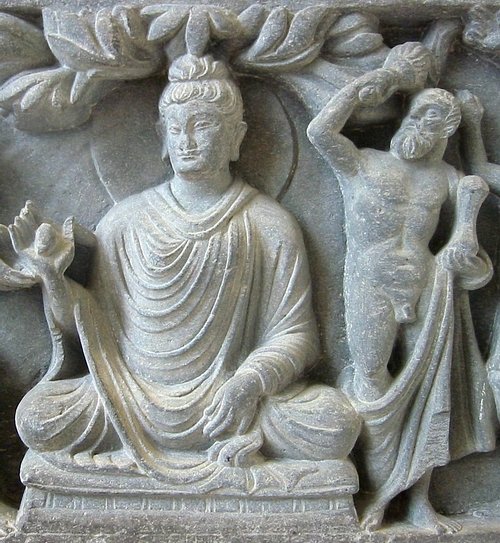
Deities from the Greek mythological pantheon also tend to be incorporated in Buddhist representations, displaying a strong blend. In particular, Herakles (of the type of the Demetrius coins, with club resting on the arm) has been used aplenty as the symbol of Vajrapani, the protector of the Buddha. Other Greek deities freely used in Greco-Buddhist art are view of Atlas, and the Greek wind god Boreas. Atlas in particular tends to be involved as a sustaining element in Buddhist architectural elements. Boreas became the Japanese wind god Fujin through the Greco-Buddhist Wardo. The mother deity Hariti was inspired by Tyche.
Soon, the figure of the Buddha was incorporated within architectural designs, such as Corinthian pillars and friezes. Scenes of the life of the Buddha are typically depicted in a Greek architectural environment, with protagonist wearing Greek clothes.
Mathura art
Mathura, 145 km south of Delhi, is by tradition the birthplace of Krishna, one of the two chief deities in Hindu religion. Mathura is also famous as one of the first two centres of production for images of the Buddha, the other being Gandhara. Human images of the Buddha began to appear at about the same time in both centres in the 1st Century CE but can be distinguished from one another as the Gandharan images are very clearly Greco-Roman in inspiration with the Buddha wearing wavy locks tucked up into a chignon and heavier toga-like robes. The Buddha figurines produced in Mathura more closely resemble some of the older Indian male fertility gods and have shorter, curlier hair and lighter, more translucent robes. Mathuran art and culture reached its zenith under the Kushan dynasty which had Mathura as one of their capitals, the other being Purushapura (Peshawar).
The Mathura images are related to the earlier yakṣa (male nature deity) figures, a likeness mostly evident in the colossal standing Buddha images of the early Kushān period. The sculptors worked for centuries in the speckled, red sandstone of the locality and the pieces carried far and wide. In these, and in the more representative seated Buddhas, the overall effect is one of enormous energy. The shoulders are broad, the chest swells, and the legs are firmly planted with feet spaced apart. Other characteristics are the shaven head; the usnīsa (knob on the top of the head) indicated by a tiered spiral; a round smiling face; the right arm raised in abhaya-mudrā (gesture of reassurance); the left arm akimbo or resting on the thigh; the drapery closely moulding the body and arranged in folds over the left arm, leaving the right shoulder bare; and the presence of the lion throne rather than the lotus throne. Later, the hair began to be treated as a series of short flat spirals lying close to the head, the type that came to be the standard representation throughout the Buddhist world.
The female figures at Mathura, carved in high relief on the pillars and gateways of both Buddhist and Jaina monuments, are truly sensuous in their appeal. These richly bejewelled ladies, ample of hip and slender of waist, standing suggestively, are reminiscent of the dancing girls of the Indus Valley. Their gay, impulsive sensuality in the backdrop of a resurgent doctrine of piety and renunciation is an example of the remarkable tolerance of the ancient Indian outlook on life, which did not find such display of art and culture improper. These delightful nude or semi-nude figures are shown in a variety of toilet scenes or in association with trees, indicating their continuance of the yakṣī (female nature deity) tradition seen also at other Buddhist sites, such as Bhārhut and Sānchi. As auspicious emblems of fertility and abundance they commanded a popular appeal that persisted with the rise of Buddhism.
Infusion of literature
All this did not remain confined in sculptures and statues alone. They seeped into the language as well in northern India during the Greek rule. A few common Greek words were adopted in Sanskrit, such as words related to writing and warfare:
- "ink" (Sankrit: melā, Greek: μέλαν "melan")
- "pen" (Sanskrit:kalamo, Greek:κάλαμος "kalamos")
- "book" (Sanskrit: pustaka, Greek: πύξινον "puksinon")
- "bridle", a horse's bit (Sanskrit: khalina, Greek: χαλινός "khalinos")
- "centre" (Sanskrit: kendram, Greek: κενδρον "kendron")
- a "siege mine" (used to undermine the wall of a fortress): (Sanskrit: surungā, Greek: σύριγγα "suringa")
- "barbarian, blockhead, stupid" (Sanskrit: barbara, Greek:βάρβαρος "barbaros")
also: "a shell" cambuka from σαμβύκη, "flour" samita from σεμίδαλις.
Phraotes, the Indo-Parthian King of Taxila received a Greek education at the court of his father and spoke Greek fluently. The Greek philosopher Apollonius recounts a talk on this:
"Tell me, O King, how you acquired such a command of the Greek tongue, and whence you derived all your philosophical attainments in this place?" The king replies, “My father, after a Greek education, brought me to the sages at an age somewhat too early perhaps, for I was only twelve at the time, but they brought me up like their own son; for any that they admit knowing the Greek tongue they are especially fond of, because they consider that in virtue of the similarity of his disposition he already belongs to themselves."
Greek was still in official use until the time of Kanishka (120 CE):
He (Kanishka) issued (?) an edict(?) in Greek and then he put it into the Aryan language". …but when Kanishka refers to "the Aryan language" he surely means Bactrian …”By the grace of Auramazda, I made another text in Aryan, which previously did not exist". It is difficult not to associate Kanishka's emphasis here on the use of the "Aryan language" with the replacement of Greek by Bactrian on his coinage. The numismatic evidence shows that this must have taken place very early in Kanishka's reign …” — Prof. Nicholas Sims-Williams (University of London).
The Greek script was used not only on coins, but also in manuscripts and stone inscriptions as late as the period of Islamic invasions in the 7th-8th century CE.
Astronomy & astrology
Vedanga Jyotisha is dated to around 135 BCE. It is an Indian text on Jyotisha (astrology and astronomy), compiled by Lagadha. The text is the earliest groundwork in India to the Vedanga discipline of Jyotisha. The text describes rules for tracking the motions of the sun and the moon in horoscopic astrology and advanced astronomical knowledge. Next to this compilation, one of the earliest Indian writings on astronomy and astrology, titled the Yavanajataka or "The Saying of the Greeks", is a translation from Greek to Sanskrit made by "Yavanesvara" ("Lord of the Greeks") in 149–150 CE under the rule of the Western Kshatrapa King Rudrakarman I. The Yavanajataka contains instructions on calculating astrological charts (horoscopes) from the time and place of one's birth. Astrology flourished in the Hellenistic world (particularly Alexandria) and the Yavanajataka reflects astrological techniques developed in the Greek-speaking world. Various astronomical and mathematical methods, such as the calculation of the 'horoskopos' (the zodiac sign on the eastern horizon), were used in the service of astrology.
Another set of treatises, the Paulisa Siddhanta and the Romaka Siddhantas, are attributed to later Greco-Roman influence in India. The Paulisa Siddhanta has been tentatively identified with the works of Paulus Alexandrinus, who wrote a well-known astrological hand-book.
Indian astronomy is widely acknowledged to be influenced by the Alexandrian school, and its technical nomenclature is essentially Greek: "The Yavanas are barbarians, yet the science of astronomy originated with them and for this they must be reverenced like gods", this is a comment in Brihat-Samhita by the mathematician Varahamihira. Several other Indian texts show appreciation for the scientific knowledge of the Yavana Greeks.
Spur on Indian & Greek Thought & Religion
The impact of the Indo-Greeks on Indian thought and religion is unknown. Scholars believe that Mahāyāna Buddhism as a distinct movement began around the 1st century BCE in the North-western Indian subcontinent, corresponding to the time and place of Indo-Greek flowering.
The Mahāyāna tradition is the larger of the two major traditions of Buddhism existing today, the other being that of the Theravāda school. According to the teachings of Mahāyāna traditions, "Mahāyāna" also refers to the path of seeking complete enlightenment for the benefit of all sentient beings, also called "Bodhisattvayāna", or the "Bodhisattva Vehicle. Among the earliest and most important references to the term Mahāyāna are those that occur in the Lotus Sūtra dating between the 1st century BC and the 1st century CE. Seishi Karashima has suggested that the term first used in an earlier Gandhāri Prakrit version of the Lotus Sūtra was not the term mahāyāna but the Prakrit word mahājāna in the sense of mahājñāna (great knowing). At a later stage when the early Prakrit word was converted into Sanskrit, this mahājāna, being phonetically ambivalent, was mistakenly converted into mahāyāna, possibly due to what may have been a double meaning
Intense multi-cultural influences have indeed been suggested in the appearance of Mahāyāna. According to Richard Foltz, "Key formative influences on the early development of the Mahāyāna and Pure Land movements, which became so much part of East Asian civilization, are to be sought in Buddhism's earlier encounters along the Silk Road". As Mahāyāna Buddhism emerged, it received "influences from popular Hindu devotional cults (bhakti), Persian and Greco-Roman theologies which filtered into India from the northwest".
Many of the early Mahāyāna theories of reality and knowledge can be related to Greek philosophical schools of thought: Mahāyāna Buddhism has been described as "the form of Buddhism which (regardless of how Hinduized its later forms became) seems to have originated in the Greco-Buddhist communities of India, through a conflation of the Greek Democritean-Sophistic-Skeptical tradition with the rudimentary and unformulated empirical and sceptical elements already present in early Buddhism". However, this view can hardly explain the origin of the bodhisattva ideal, already delineated in the Aagamas, which also already contained a well developed theory of selflessness (anaatman) and emptiness (shunyaata), none of these essential Mahāyāna tenets being traceable to Greek roots.


